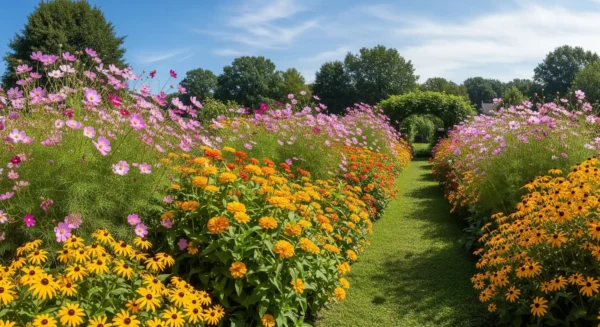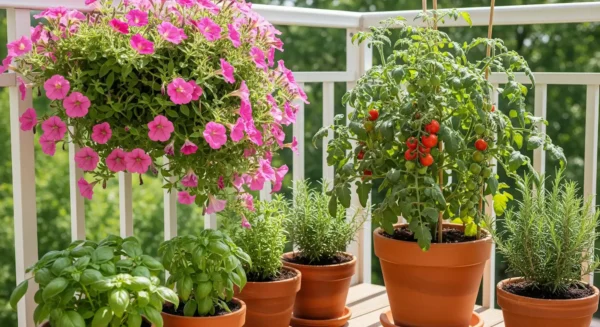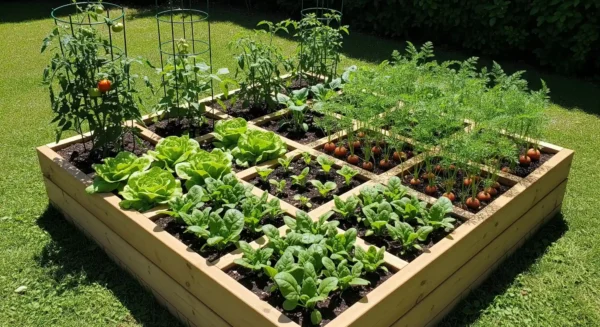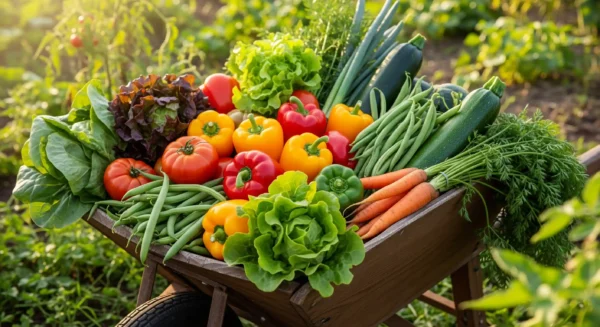Prepared to flourish? How to Choose Your Perfect First Garden (A Beginner’s Guide!)
That small tug toward the ground, a silent message implying that tending to life brings delight. You see beautiful gardens online, you admire a neighbor’s blooming flower pots, and you think to yourself, “I’d love to do that.” But then comes the big, overwhelming question: “But where do I even begin?” You’re faced with a confusing world of options—vegetables, flowers, herbs, pots, plots, raised beds—and it’s enough to make anyone put the dream on hold before it even has a chance to sprout.
Allow me to let you in on a secret of sorts. Selecting your first garden type is not about discovering the “one right answer” that suits everyone. It’s about discovering the one that fits your life, your surroundings, and your own place exactly. This book is your personal garden matchmaker, here to help you sort through the uncertainty, quiet the overwhelm, and identify a happy beginning place that will position you for success.
From a basic, aromatic windowsill herb garden to a classic, useful in-ground vegetable patch, we will dissect the most common garden designs. More importantly, we’ll provide you a basic framework to identify your perfect match depending on your actual life. Starting this journey doesn’t call for a large yard or a legendary “green thumb.” All you need is a little curiosity and a guide to get you headed on the correct path. Come find the garden just waiting for you.
Before You Dig: Garding’s Four Golden Questions
The ideal garden is one that fits your life rather than one that causes stress. So let’s determine what you are working with before we ever consider seeds or soil. Responding honestly and deliberately to these four “golden questions” will provide you a strong road map for choosing the best course of action.
First question: Describe your space.
Here is the beginning. Look realistically, without judgment, at what you already own. Does the backyard stretch out enough for wandering? An afternoon sunlit concrete terrace that bakes? A third floor little apartment balcony? Alternatively perhaps just one, sun-drenched kitchen window sill? A limited place should not demoralize you! A few pots contain some of the most exquisite and efficient gardens. The intention is to align the ambition of the garden with the reality of the site. We have a solution for all of these situations; be specific: “I have a 6-foot by 4-foot balcony,” or “I have one south-facing window that gets bright light.”

Second question: How much sun do you get?
This is the most important, non-negotiable element influencing your plants’ condition. All growth is driven by photosynthesis, the technique plants employ to make food from sunlight. Become a “sun detective” for the next sunny day. At 9 AM, noon, and 3 PM go outside (or gaze out your window). The sun is hitting somewhere here. It stays there for how long?

- Six to eight plus hours of direct, unfiltered sunlight define a full sun. Most crops that produce fruit—such as tomatoes, peppers, cucumbers, squash—as well as sun-loving flowers—such as zinnias, marigolds, and sunflowers—should find this powerhouse zone ideal.
- Usually in the morning or late afternoon, part sun/part shade equals 4-6 hours of direct sun. Perfect for many leafy greens (including lettuce, spinach, kale), most root crops (including carrots and radishes), and a great range of gorgeous flowers including hydrangeas, coral bells, and astilbe, this is a beautifully flexible light level.
- Shade: Usually dappled or indirect, this indicates fewer than four hours of direct sun. You can certainly have a rich, green oasis even though you won’t be growing tomatoes here. Beautiful foliage plants including hostas, ferns, caladiums, and flowering beauties like impatiens and begonias fall into this realm.
Third question: How much time you commit?
Speak quite honestly with yourself. Are you searching for a pleasant weekend activity you could spend some hours on or a quiet daily ritual involving five minutes with your morning coffee? One pot of herbs could just need one minute daily watering. Ten containers taken together will call for greater attention. A sizable in-ground garden will call for weekly focused attention for weeding, watering, and pest-control. The intention is to make you happy, not to add yet another item to your agenda. Starting with a “low-time” garden doesn’t carry any guilt!
Fourth question: What do you aim to accomplish?
What “why” drives your wish to garden? Your basic drive will direct your decisions more than anything else. What would your dream garden offer?
- Would you like to raise your own food? Are your dreams about the taste of a homegrown tomato or the ease of snipping your own salad greens? ( hello, vegetable garden!)
- Are you planning to cut lovely, fresh flowers for your house? Do you see bringing in vibrantly colored blooms throughout summer? (You would be suited for a cut-flower garden.)
- Do you just wish to design a peaceful, green area to decompress? Your aim is a lovely, leafy haven? (Possibly a leaf and flower garden.)
- Are you trying to find an interesting, instructive project to undertake with kids? Would you like to show them hands-on where food originates? (A basic Herb or “Pizza” garden is ideal.)
Your Personal Garden Matchmaker: Selecting the Correct Fit
Once you have the responses to your Golden Questions, let us choose your ideal garden mate! Consider these as flexible beginning points rather than as strict divisions.
The Container Garden: Any Size Instant Gratification
Perfect for renters who require a portable garden, beginners with limited space (balconies, patios, stoops), or anyone looking to start small and have total influence over their surroundings.
benefits:
- Total Soil Control: Your yard’s clay, rocky, or poor-quality soil need not cause you concern. From day one, you supply the ideal fluffy potting mix.
- Ideal for Small Spaces: You have garden space if you could fit a five-gallon pail. This is the best democratizer of gardening available.
- Portable and flexible: Is your place beginning to be shaded by a tree? Just rearrange your pots. Anytime you can modify your space or follow the sun as the seasons change.
- Low Startup Cost & Minimal Weeding: Starting with one pot and seed package will allow you to. Weeding is not at all common.
Constraints:
- Pots, particularly unglazed terra cotta, can dry up very rapidly in the summer sun and typically call for daily, maybe twice-daily watering.
- Restricted Growth: The size of the pot finally determines the extent of the root system of the plant, thereby affecting the yields and size of smaller plants as compared to in-ground choices.
- Plants will rely on you for consistent fertilizer feeding since they consume the nutrients in the soil of a container rather rapidly.
Many newcomers mistakenly think, “You can’t grow’real’ food in pots.” This is absolutely untrue! From containers, your harvest can be rather fruitful. Think high-yield plants include determinate (bush) tomatoes, eggplants, lettuce, radishes, almost every herb available. The secret is selecting “bush” or compact types and providing a big enough pot.

Perfect starting project: a “salad bowl” pot loaded with arugula, spinach, and loose-leaf lettuces. Alternatively attempt a “Pizza Pot” using some oregano, a basil plant, and a small tomato plant. A classic for a reason is a single big pot with a “thriller, filler, spiller” mix for flowers—one tall plant, some mounding plants, and a trailing plant.
The Raised Bed Garden: The Ideal Combining of Control and Release
Ideal for homeowners who want a neat, committed garden but do not want the labor-intensive job of altering challenging native soil. For gardeners with back or knee problems, it’s also a great, comfortable choice.
Advantages:
- Its superpower is perfect soil, immediately. You totally avoid any problems with your native soil by stuffing the bed with a wonderful, fluffy combination of compost, topsoil, and amendments.
- Great Drainage: Most plants detest sitting in damp ground. Raised beds help to prevent root rot by letting extra water flow naturally away.
- Less bending and kneeling makes planting, weeding, and harvesting far more comfortable and easy.
- Raised beds help your landscape to look neat, defined, and orderly.
- Usually allowing you to plant a week or two earlier, a raised bed’s soil is lifted off the cold ground, thus heats it faster in the spring.
Negative aspects include:
- Higher Initial Cost: Materials (wood, metal, or composite for the frame), hardware, and a lot of soil and compost to fill it are upfront investments.
- Like containers, the raised soil might dry out faster than in-ground gardening, hence you will have to pay particular attention to watering.
Statistically, raised bed gardening has become rather popular within the past decade. One of the fastest-growing areas in home gardening, it’s exactly because it eliminates the one major obstacle for novices: poor soil.
Perfect, reasonable size for a starter project is one 4×4 foot raised bed. The “square foot gardening” approach lets you plant it heavily. See it as a grid of sixteen squares, and plant a different easy vegetable in each one: a square of carrots, a square of radishes, one with a bush bean plant, one with spinach, and so forth. That’s a great and very efficient approach to start.
The Classy and Most Economical Choice: The In-Ground Garden
Perfect for those with pretty excellent soil available in their yard. Growing a lot of food or flowers this traditional and economical method is the best one.
advantages:
- Lowest Startup Cost: All you need if your soil is suitable are seeds and some simple hand equipment. Nothing has to be bought or built.
- Excellent Moisture Retention: In-ground gardens maintain moisture longer than raised beds or pots since the surrounding ground functions as a massive sponge.
- Unrestricted Root Growth lets you realize maximum potential for big plants including fruit trees, spreading squash, or even indeterminate vining tomatoes.
- Your plants create a more robust and natural surroundings by directly interacting with the nearby soil ecosystem of earthworms, helpful bacteria, and fungus.
drawbacks include:
- You may have to remove current sod, till or “double dig” the ground to loosen it, then amend it with compost.
- You will be in a continuous fight against dormant weed seeds buried in the ground. You really must mulch.
- You are therefore at the mercy of the pH, texture, and nutrient content of your local soil, which may call for certain amendments and tests.
Starting small is a pro tip. Till a large 20×20 foot plot, it is rather appealing; but, it soon becomes an overpowering, weedy disaster that keeps you from ever planting once more. For a novice, a 4×8 foot plot is a great, highly controllable size that yet generates an incredible volume of food.
Perfect first project: a classic “Three Sisters” styled garden with a few stalks of corn, pole beans grown to climb them, and a squash plant to ramble at the base. Alternatively, for flowers, a basic “cut flower” patch including easily grown, high-yield annuals such sunflowers, cosmos, and zinnias.
The Easiest, Most Rewarding Beginning Source: The Herb Garden
Perfect for the absolute novice looking for almost assured success, the passionate cook yearning fresh taste, or the gardener with just sunny windowsills.

Cons:
- Ideal for any place, indoors or outside, most herbs flourish in little pots.
- Comparatively to store-bought herbs, they offer incredible taste and can save a lot of money.
- “Cut-and-Come-Again”: Plants like basil, parsley, and cilantro grow back more often the more you harvest from them, therefore offering a continual supply.
- Many Mediterranean herbs, including rosemary, thyme, oregano, are rather drought-tolerant; many are also rather low-maintenance.
Cons are:
- Some herbs, such as mint and lemon balm, have great aggressiveness and their roots will disperse everywhere. They should always be housed in a container to stop them from invading your grass and garden.
Think of them as a “sensory garden” rather than as a food source. Herbs engage all your senses in a way few other plants can—the pungent fragrance of rosemary on your fingers, the sight of vivid purple basil, the complex taste of fresh parsley, the fuzzy texture of a sage leaf.
Perfect starting project: a basic trio of pots on a windowsill or patio: one for basil, parsley, and mint (in their own pot!). Alternatively create a “cocktail garden” combining lavender (for syrups) with mint, rosemary (for muddling).
Comparison at a Glance: Which Garden Sufits Your Style?
Here is a basic comparison of the main elements for every form of garden to assist you to confirm your choice.
| Garden Style | Ideal for (space) | Sunlight’s Requirements | Approx. Time/Week | Approx. Starting Price | Main Advantage |
|---|---|---|---|---|---|
| Storage container | Patio or Balcony | Variances (adaptable) | Two to four hours | Low ($) | Maximum adaptability |
| Growing Bed | Small/Medium Yard | Full Sun, Ideal | 3 to 5 hours | Medium ($$) | Perfect Control of Soil |
| Ground | Medium/Big Yard | Full Sun, Ideal | Four to six plus hours | Very Low ($) | Lowest Cost and Big Scale |
| Herbs | Windowsills/ pots | vary | One or two hours. | Very Low ($) | simplest success |
Your Garden is a Journey, Not a Destination at Conclusion.
By now you should know exactly how to approach selecting your first garden type. The most crucial lesson is that the best garden is just one that makes you happy and matches your life. Recall that this is only temporary decision. Gardening is an evolutionary trip of learning rather than a one-time test you could fail.
Beginning small is a good approach. One wild success is a single potful of basil you nurture to and gather from. A victory is a little patch of zinnias that provides a few lovely bouquets. Your first year should be focused on developing confidence and delight rather than generating a huge, magazine-worthy crop. Your garden will develop and alter just as you do. Next year you might add more containers, create a second raised bed, or enlarge your in-ground plot. Starting is most crucial of all.
FAQ: Addressing Your Initial Garden Anxiety
Are novices better off starting a raised bed garden?
For beginners with a yard, a raised bed is usually the best option. It lets you avoid the one major unknown factor for a beginner gardener: the condition of your local soil. Filling it with a perfect mix from the beginning helps you avoid several possible issues such poor drainage, compaction, and nutrient shortages, so preparing yourself for a regulated, successful, and confident first experience.
Which kind of garden is most easily maintained?
Small, well-planned gardens are hands down the easiest ones to maintain. The least difficult will be a single, well-mulched raised bed or a small container garden (five to ten pots), which drastically cuts weeding. The size of the garden is more important than the type of one in determining “easy.” Maintaining fun and avoiding it from turning into a cause of stress depend on starting at a reasonable scale.
Which of a veggie garden and a floral garden best suits me?
Review your response to the fourth Golden Question: What is your objective? Start with vegetables if your main driving force is great, mouthwatering cuisine. Start here if you want to have flowers for your house, draw pollinators, and create beauty. Still, you have no choice! Usually, the best gardens accomplish both. Known as “edible landscaping,” you could arrange rows of gorgeous, pest-deterring marigolds between your tomatoes or toss edible flowers like pansies and nasturtiums with your salad greens. Many vegetables, as the blossoms on a scarlet runner bean, are beautiful in their own right.
Suppose I choose the “wrong” type?
Allow me to reassure you: no type is “wrong”. There is simply learning involved. You are ready to make investments in a raised bed next season if you start with containers on your patio and find yourself wanting you more area for larger plants. Starting a large in-ground garden and finding by July that it is too much to maintain will teach you that cutting back to a few productive raised beds will make you happier. One adaptable and forgiving activity is gardening. Every season offers an opportunity to try something different, brand-new. The only error is allowing your fear of making one prevent you from starting at all.









